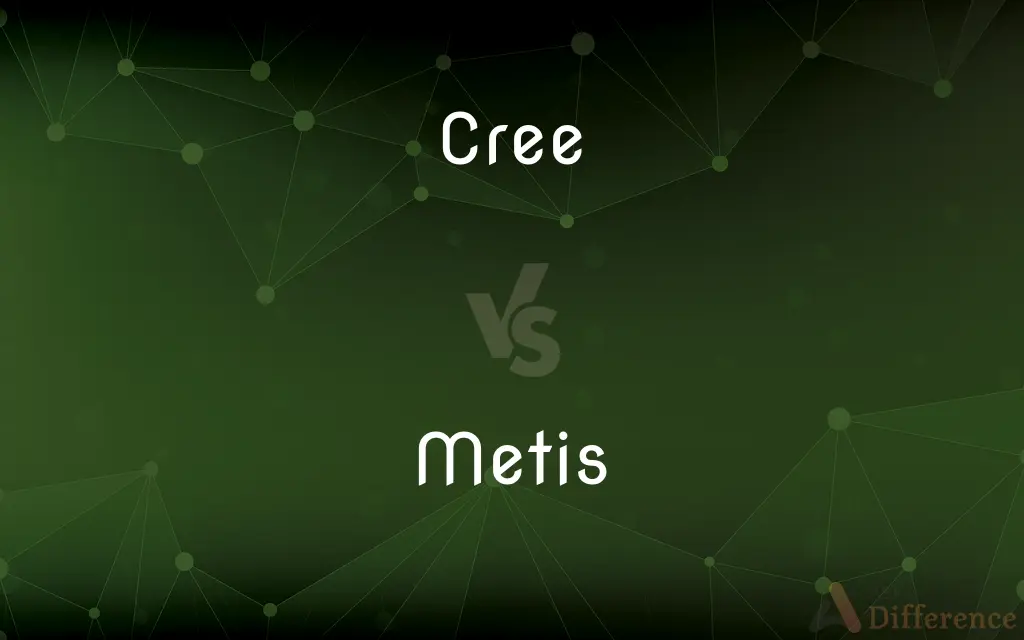Cree vs. Metis — What's the Difference?
By Urooj Arif & Maham Liaqat — Updated on April 19, 2024
Cree are a large group of First Nations in Canada, known for their Algonquian language; Metis are a distinct indigenous group of mixed Indigenous and European ancestry.

Difference Between Cree and Metis
Table of Contents
ADVERTISEMENT
Key Differences
The Cree are one of the largest groups of First Nations in Canada, primarily speaking the Algonquian language and located across various provinces. Whereas the Metis are recognized as one of Canada's three distinct Aboriginal peoples, characterized by their mixed Indigenous and European heritage, particularly French, Scottish, and Irish.
The Cree traditionally engaged in subsistence hunting and fishing, with societal structures deeply connected to the land. On the other hand, the Metis culture emerged distinctly with elements like the Red River Cart and the Michif language, reflecting their mixed lineage.
The Cree people have a rich tradition of storytelling, spiritual practices, and community ceremonies that emphasize their connection to nature. In contrast, Metis communities often celebrate their heritage through events like the annual Metis Fest, showcasing music, dance, and traditional crafts that highlight their unique cultural synthesis.
Historically, the Cree participated extensively in the fur trade as trappers and guides due to their vast knowledge of the land. Meanwhile, the Metis are famously known for their role in the fur trade as middlemen and interpreters, playing a critical role in the economic exchange between Europeans and various indigenous tribes.
Governance among the Cree involves traditional and modern forms of leadership including chiefs and councils recognized under the Indian Act, while Metis governance features a democratic system with representation through the Metis National Council, emphasizing political autonomy and cultural preservation.
ADVERTISEMENT
Comparison Chart
Identity
Indigenous people of Canada, Algonquian speakers
Mixed Indigenous and European ancestry
Language
Cree (Algonquian language family)
Michif (mix of Cree and French)
Culture
Rich in storytelling and spiritual practices
Combines Indigenous and European elements
Historical Role
Significant in fur trade as trappers and guides
Key players in fur trade as middlemen
Governance
Traditional chiefs and modern councils under the Indian Act
Democratic, represented by Metis National Council
Compare with Definitions
Cree
Cree spirituality and ceremonies play a significant role in their culture.
Cree ceremonial practices often include drumming and singing.
Metis
The Metis language, Michif, uniquely combines Cree and French elements.
Michif is spoken by the Metis, preserving their linguistic heritage.
Cree
A group of Native American people living in Canada, known for their Algonquian language.
The Cree in Saskatchewan participate in annual cultural festivals.
Metis
The Metis are governed by the Metis National Council, emphasizing self-representation.
The Metis National Council advocates for the rights and interests of Metis communities.
Cree
Cree languages belong to the Algonquian language family, spoken by over 96,000 people.
He speaks Cree, which is vital for communicating with elders in his community.
Metis
Metis culture is celebrated through music, dance, and festivals like Metis Fest.
The Metis Fest features traditional jigging and fiddle playing.
Cree
Traditionally, the Cree economy was based on hunting and fishing.
Traditional Cree diets are heavily influenced by their historical reliance on hunting.
Metis
Historically, Metis were vital as intermediaries in the North American fur trade.
His Metis ancestors worked as fur trade interpreters.
Cree
Cree social structure is organized around bands and tribal councils.
The local Cree council meets monthly to discuss community issues.
Metis
A recognized Aboriginal people in Canada with mixed Indigenous and European ancestry.
She is proud of her Metis heritage, especially during cultural celebrations.
Cree
The Cree (Cree: Néhinaw, Néhiyaw, etc.; French: Cri) are a North American indigenous people. They live primarily in Canada, where they form one of that country's largest First Nations.
Metis
The satellite of Jupiter that is closest to the planet.
Cree
A member of a Native American people inhabiting a large area from eastern Canada west to Alberta and the Great Slave Lake. Formerly located in central Canada, the Cree expanded westward and eastward in the 17th and 18th centuries, the western Cree adopting the Plains Indian life and the eastern Cree retaining their woodland culture.
Metis
A person of mixed racial ancestry.
Cree
The Algonquian language of the Cree.
Metis
Often Métis A person of mixed Native American and French Canadian ancestry.
Cree
A member of an Algonquian people living in central Canada
Metis
A person of mixed-race ancestry.
Cree
The Algonquian language spoken by the Cree people
Metis
(US) A person of one-eighth black ancestry; an octoroon.
Metis
(knowledge management) Practical intelligence; street smarts.
Metis
Of mixed heritage
Metis
Of Métis heritage.
Metis
The offspring of a white person and an American Indian.
Metis
The offspring of a white person and a quadroon; an octoroon.
Metis
A half-breed of white and Indian parentage
Common Curiosities
How do the Cree govern themselves?
The Cree governance system includes traditional chiefs and councils under the Canadian Indian Act.
What are key aspects of Cree culture?
Cree culture includes storytelling, spiritual practices, and community ceremonies.
What language do the Cree speak?
The Cree speak the Cree language, part of the Algonquian language family.
Who are the Metis?
The Metis are a distinct group of Aboriginal people in Canada with mixed Indigenous and European ancestry.
What language do the Metis speak?
The Metis primarily speak Michif, which combines Cree and French elements.
What role did the Metis have in history?
The Metis were crucial intermediaries in the fur trade, acting as middlemen and interpreters.
What is Metis culture like?
Metis culture includes a synthesis of Indigenous and European elements, celebrated through events like Metis Fest.
Who are the Cree?
The Cree are a large group of Native Americans in Canada known for their Algonquian language.
How do the Cree and Metis differ in their historical roles?
The Cree were primarily trappers and guides in the fur trade, while the Metis acted as intermediaries.
What is the traditional economy of the Cree?
The traditional Cree economy is based on hunting and fishing.
What are some traditional Cree ceremonies?
Traditional Cree ceremonies include sweat lodges and powwows, which are integral to their cultural practices.
How are the Metis governed?
The Metis are represented by the Metis National Council, which promotes their political autonomy.
What events showcase Metis culture?
Metis culture is showcased in events like Metis Fest, which features traditional music, dance, and crafts.
What is the significance of the Michif language?
Michif is significant as it reflects the mixed heritage of the Metis and is vital for cultural preservation.
Can you explain the spiritual practices of the Cree?
Cree spiritual practices often involve ceremonies that are deeply connected to nature, including drumming and seasonal festivals.
Share Your Discovery

Previous Comparison
Cursive vs. Italic
Next Comparison
Postering vs. FosteringAuthor Spotlight
Written by
Urooj ArifUrooj is a skilled content writer at Ask Difference, known for her exceptional ability to simplify complex topics into engaging and informative content. With a passion for research and a flair for clear, concise writing, she consistently delivers articles that resonate with our diverse audience.
Co-written by
Maham Liaqat













































